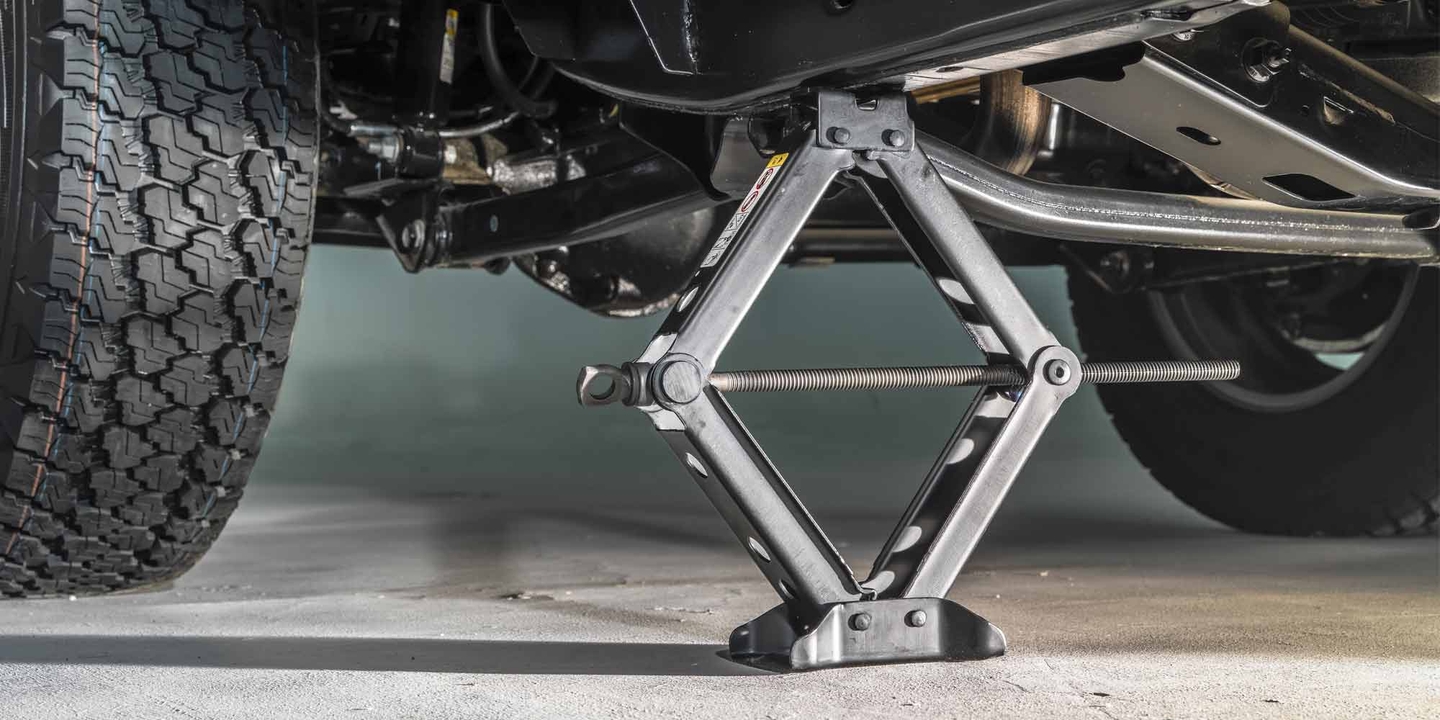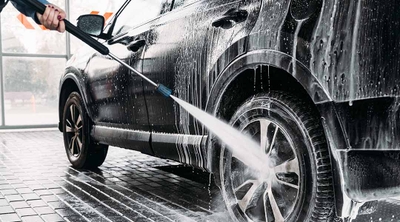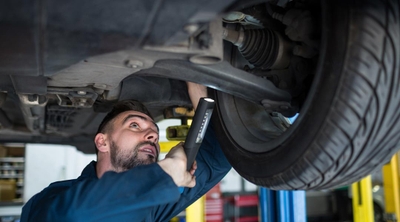How to use a car jack
5 min read
Using a car jack can be intimidating, as well as dangerous. But with the proper safety precautions and procedures, as well as plenty of common sense, you can lift your vehicle and fix a flat tire without hurting yourself or damaging your vehicle. Here we’ll cover the different types of spare tire car jacks available, and we’ve included many important safety tips as well as the proper techniques for correct lifting and lowering.
Do cars come with jacks?
Car companies began including scissor jacks, as well as other jack designs, in the trunks of cars in the 1950s (along with the spare tire). That practice remained universal until recently. Today, most new cars and trucks still come with a jack and a spare; however, some models don’t in order to save weight and increase fuel economy.
Over the decades, there have been many car jack designs used by automakers or sold in stores, ranging from scissor jacks, also known as screw jacks, to hydraulic floor jacks, bottle jacks, and even pneumatic car jacks that lift the vehicle with compressed air. But the most common types used today are the trusty scissor (because of its trunk-friendly compact packaging) and the hydraulic floor jack, which is used more often by car enthusiasts, professional mechanics, and even NASCAR pit crews.
Is there a jack lifting range for different vehicles?
Both types of car jacks come in many shapes and sizes to lift small cars, heavier large cars, and higher-riding trucks and SUVs. If you’re going to purchase a car jack, make sure you get one with the proper weight capacity to lift your vehicle safely. The smallest jacks are designed to hold about one ton of weight and only work with mini compact cars. The next size up can handle about two tons of weight and works well with many passenger cars.
If you drive a larger vehicle like an SUV or pick-up truck, you may need to invest in a sturdier jack with a higher weight capacity. The largest ones can hold up about six tons. Be sure to check that the weight capacity of a jack is adequate to lift your vehicle.
Note that there are different ways to calculate car weights — dry weight includes just the car itself, curb weight accounts for the added weight of fuel, and gross vehicle weight incorporates passengers too. When choosing the best jack for your car, base your decision on the car’s curb weight. Prices for jacks range from about $30 for the lightest duty scissor jack that can lift one ton, to about $300 for a high-capacity, three-ton hydraulic unit made of lightweight aluminum. But you don’t have to spend that much to get a high-quality hydraulic floor jack — many are available for less than $100 online.
How to use a scissor jack or hydraulic car jack
A scissor jack and hydraulic car jack will both get the job done in the end, but the way they work is a little different. The main quality that sets a hydraulic jack apart from a standard scissor jack is the speed. It’s able to lift a car quicker and with less effort on your part. However, hydraulic jacks are bulkier and harder to store in the trunk of your car. Scissor jacks are much easier to store in a standard-sized passenger car.
1. Place the jack properly
If you’re going to lift your car with the manufacturer-supplied car jack, check the owner’s manual for the proper placement of the jack underneath the vehicle, which is probably on the “pinch weld” located between the front and rear tires. If you place the jack incorrectly you can damage the vehicle — or worse, it will slide off the jack, which is dangerous. If you’re jacking up a vehicle with a store-bought hydraulic floor jack, be sure to place it on a frame rail or some other sturdy structure of the vehicle’s undercarriage between the front and rear tires and away from fuel lines and other fragile parts.
2. Raise the car slowly
Once you have the jack placed properly, with the vehicle on the flat ground and at least one wheel chocked, you’re ready to lift the car. If you’re using a scissor jack, insert the rod, or place the wrench over the knob and begin to crank to the right. It should slowly rise and engage with the vehicle, which will add some resistance. Keep going. At first the car will rise on its suspension; however, it will eventually top out and the tire will come off the ground. Lifting more than one wheel at a time is possible, but it’s usually unnecessary, especially for novices.
A hydraulic jack operates differently and will raise the vehicle more quickly, but it will require more space. To lift the car with a hydraulic floor jack, pump the long handle up and down until you’ve reached the required height. It should only take between three and 10 pumps depending on the jack used. Don’t lift the car any higher than you need to. Lifting the tire a few inches off the ground is sufficient to remove the wheel and change a flat or check the brakes or suspension.
3. Secure car with jack stands
Once the tire is off the ground, place your jack stands under the vehicle near the placement of the jack and lower the car until it is securely resting on the jack stands. If you’re using a scissor jack, simply turn the rod or wrench in the other direction (to the left) to lower the vehicle.
To drop the car with a hydraulic jack, twist the long handle to the left. But do so carefully. It’s very easy to turn the handle too quickly and lower the car faster than you want to. Floor jacks operate similarly to hydraulic jacks, but they’re more manual. Once you’ve lifted the car using your floor jack with a hand crank, you can lower it back onto the jack stands by slowly turning the adjustment handle in a counterclockwise direction.
When the car is resting on the jack stands, give it a little wiggle to make sure it’s secure and balanced.
4. Lower car and check lug nuts
When the job is done, use the jack to lift the vehicle off the jack stands. Remove them carefully and then slowly lower the vehicle to the ground. If you changed a wheel and tire, always recheck the tightness of the lug nuts with the car resting on the ground.
How to safely use a car jack
Never climb underneath a car held up by a car jack
Never climb underneath a car or truck when it’s supported only by a car jack. The jack can easily slip out from under the vehicle or fail, bringing thousands of pounds of weight down on top of you without warning. In other words, catastrophe. If you’re going to crawl under the vehicle, first purchase a high-quality set of jack stands. At around $35 at a big-box hardware, they’re not a big investment. Don’t use boxes, cinder blocks, or bricks as a makeshift substitute.
If you’re changing a tire, you won’t have to crawl under the vehicle, so jack stands aren’t as necessary, but they’re easy to use and they’re always a good safety precaution.
Make sure the car is on solid ground
Before you jack up any car, make sure it is on solid, level ground. Never use a car jack on dirt or grass. Also, the transmission should be in park and the parking brake engaged. If the car has a manual transmission, leave it in first gear. As an added measure of safety, chocking a tire with a wooden block is always a good idea. This will make sure the car will not attempt to roll away. If you’re lifting the front of the car, chock a back tire. If you’re lifting the rear, chock a front tire.
Never jack up a car on the side of the road
And finally, never jack up a car on the shoulder of a busy road, especially a busy freeway, interstate, or other major highway. It’s extremely dangerous, and many people are killed or severely injured every year making this mistake. If you get a flat, slow down and pull to the shoulder, but don’t stop. Put on your hazard lights and keep driving slowly to the next exit, where you’ll find a more secure place to jack up your car and install your spare tire safely. Yes, driving on the flat tire may damage your wheel; however, it’s a small price to pay in the interest of safety. Learn general car ownership tips.




